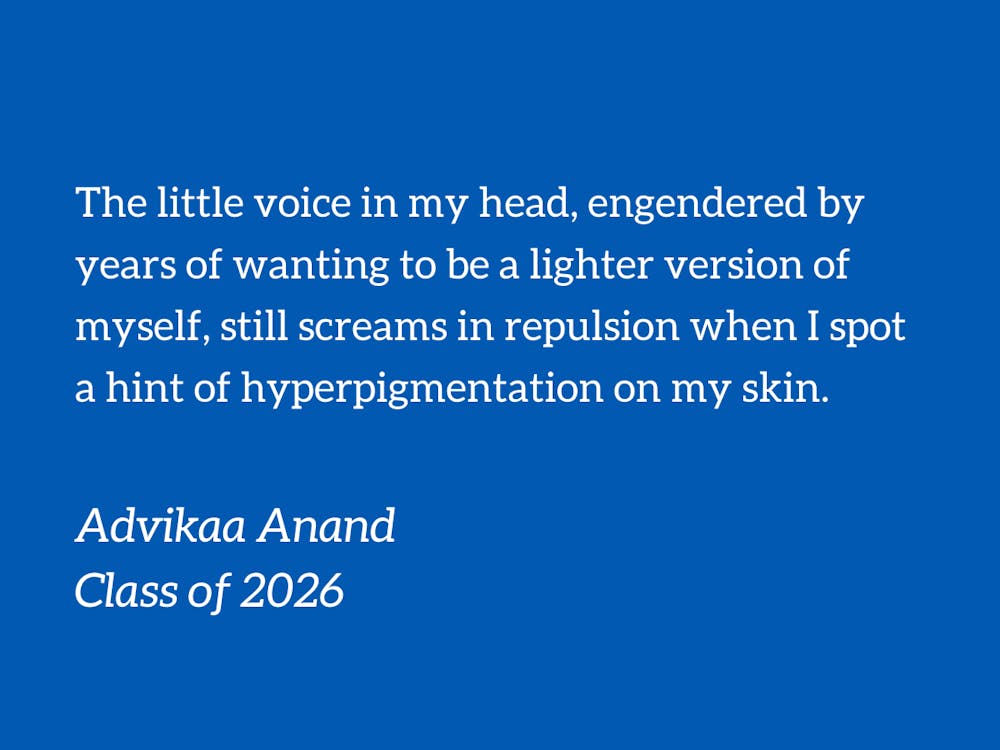“Why aren’t your lips light pink like mine?” asked the girl sitting next to me on the bus.
As I glanced at her light blue eyes and translucent blonde hair, I looked away in embarrassment, swallowing the lump in my throat. Upon arriving home, I gazed into the mirror with tears as I traced the natural hyperpigmentation on my Indian lips, ashamed of my dark skin and darker features.
This incident would mark the beginning of my attempt to conceal my Indian facial characteristics. I became obsessed with makeup, and my first makeup kit was a palette with eyeshadow and blush from Borders (the fact that I was buying makeup from a bookstore should have been my first sign that this endeavor was not such a good idea, but oh well! I live to learn!). I would layer white eyeshadow to conceal the natural dark spots dotting the skin around my eyes. Eventually, my sister got frustrated with my taking hours to get ready in front of my purple crown-shaped mirror and slammed the palette against the floor, loosening the pigments from their plastic wells.
But I would not be deterred. The next week, my nine-year-old self marched to Claire’s, the obvious place to solve one’s lack of makeup issues. There, my compulsion to look like my white classmates pushed me away from the dark shades that would flatter my deep brown eyes and towards light colors that made me appear washed out and pale.
As I grew older, my methods to appeal to the prevailing Eurocentric beauty standard became more and more extreme. I used honey to lighten my iris, intentionally ignoring the fact that its proteins can damage the white tissue in your eyes. I spent hours in the kitchen brewing lemon concoctions to adorn my hair with blonde streaks, all because I was desperate.
I was desperate to have the pink lips boasted by my classmates. I was desperate to have the light eyes and hair that embodied a beautiful Southern belle and that my brown hair, skin, and eyes were so far away from, and in this process, I had become desperate to transform into someone who wasn’t myself.
My damaging obsession was not unique to me alone; in fact, hundreds of brown women grapple with the lingering ramifications of colorism. Years of colonization in South Asia led to the conception of “whiteness [as] a source of cultural capital that [was] associated with upper-class images, luxury, prestige, and success.” Even as whiteness was rebranded into “fairness” upon the eviction of the British from the Indian subcontinent, its cultural grip remained strong, breeding “an association between fairer skin and beauty.”
As a result, brown women continuously turn to products promising lightening results, even those that have the potential to permanently damage their skin, including bleach, skin whitening creams, and brightening face washes.
YetI am learning to shed the shackles of a standard that does not serve me. I began this journey last month when I adorned my eyes with the black kohl for the first time. For years, I had been so afraid to use it in fear that it would cast a shadow on my features, but as I witnessed how its deep hue complimented my dark eyes, I realized I was conforming to a beauty standard engineered by people who looked nothing like me.
The little voice in my head, engendered by years of wanting to be a lighter version of myself, still screams in repulsion when I spot a hint of hyperpigmentation on my skin. Like this morning, when I found myself instinctively reaching towards my concealer to make it go away.
Today; however, I did something different: I pulled my hair back instead, emphasizing the dark spot even more.Because I am a brown woman, and my body is not sullied by dark spots and blotches; it is adorned by them.
Advikaa Anand is a Trinity freshman. Her columns typically run on alternate Thursdays.
Get The Chronicle straight to your inbox
Signup for our weekly newsletter. Cancel at any time.
Advikaa Anand is a Trinity sophomore and an opinion managing editor of The Chronicle's 119th volume.

